Ha Giang in June offers ideal conditions for adventurous travelers looking to conquer mountain passes with dry weather, clear skies, and excellent visibility. While occasional brief showers may occur, they typically pass quickly without significantly affecting your travel plans. This is when terraced fields begin their water-filling season, while tourist attractions, highland markets, and homestays remain bustling with visitors.
If you’re considering where to go, what to do, and what to eat when visiting Ha Giang in June, read this comprehensive guide from Phieu Travel!
1. Is the summer weather cold in Ha Giang in June?
Ha Giang in June is not cold. During the day, temperatures range from 25-33°C (77-91°F), with plenty of sunshine that isn’t oppressive thanks to the high altitude and thin mountain air. The sunlight perfectly illuminates the green mountains, keeping the scenery crisp and pleasant.
Mornings and evenings see temperatures drop to around 20-24°C (68-75°F). The air feels refreshingly cool, occasionally carrying a slight chill, especially after brief afternoon showers. For visitors accustomed to lowland climates, this might feel slightly cool, but a light jacket is sufficient for comfortably enjoying evening strolls or sunset views from mountain passes.

The Best Time to Visit Ha Giang: A Seasonal Guide to Flowers & Festivals
2. Must-visit destinations in Ha Giang in June
With clear skies, gentle sunshine, and refreshing air, June in Ha Giang is perfect for exploring nature and culture. Here are the destinations you absolutely should visit during this season.
2.1 Admire Hoang Su Phi terraced fields during water-filling season
Nestled at the foot of Tay Con Linh Mountain, Hoang Su Phi features some of Vietnam’s most beautiful terraced fields. For hundreds of years, local people have built embankments and shaped the earth, creating layers of fields that curve gracefully along mountainsides, both majestic and elegant. With their unique cultural and scenic values, Hoang Su Phi terraced fields were recognized as a National Heritage Site by the Ministry of Culture, Sports and Tourism in 2012.
By June, Hoang Su Phi enters its water-filling season. Water from the mountains flows down, covering the fields with crystal-clear layers that reflect the blue sky and clouds. Under the early summer sun, the entire landscape glistens with silver reflections. Across the hillsides, farmers take advantage of favorable water conditions to transplant rice seedlings. The sounds of people calling to each other and water flowing through wooden troughs create a lively rhythm of seasonal life amid the tranquil mountain setting.
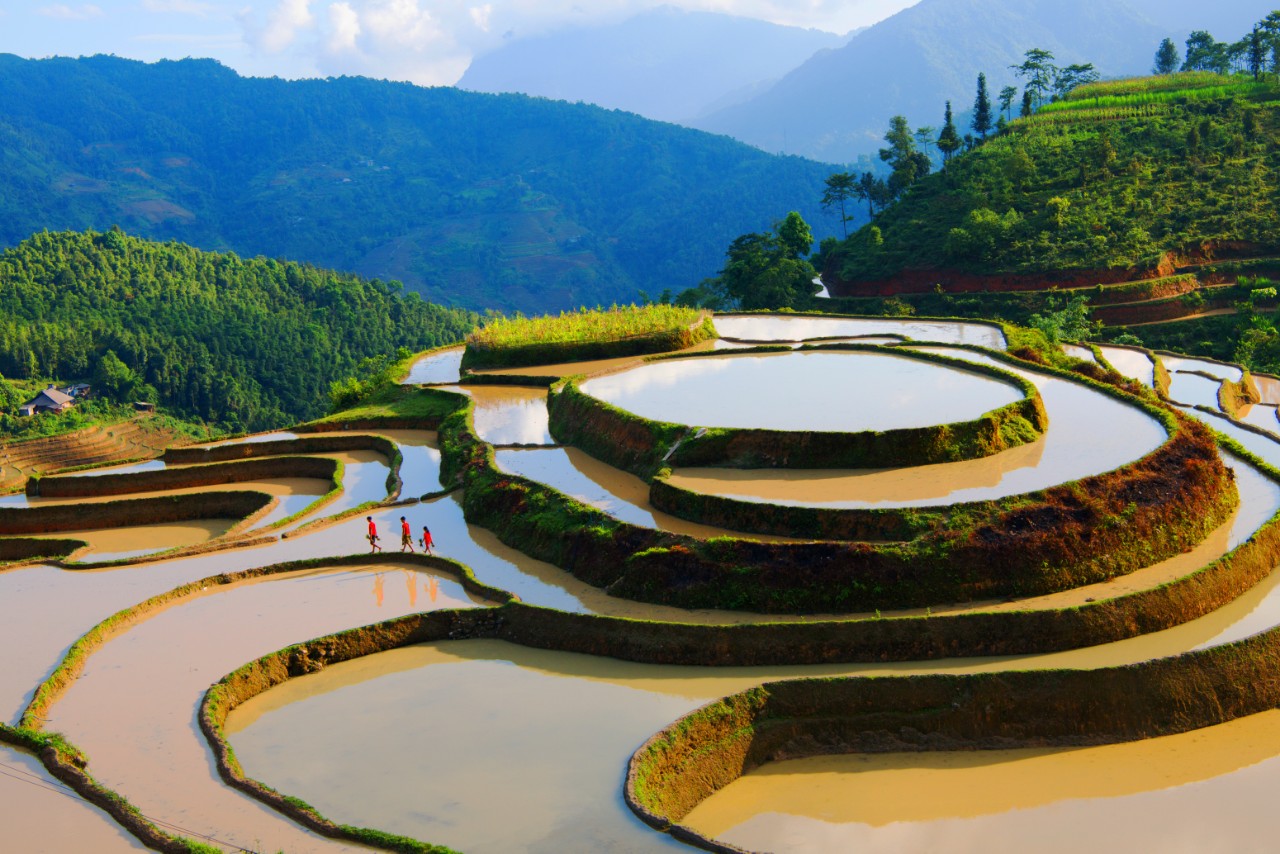
2.2 Immerse yourself in the peaceful scenery of Yen Minh pine forest
Yen Minh pine forest stretches along National Road 4C, extending across mountain slopes with straight, tall pines that remain green year-round. While the rest of Ha Giang enters the mild summer season, this area maintains its cool atmosphere, with temperatures consistently lower than surrounding regions.
Paths through the forest are red dirt trails that wind between ancient pine trunks covered with moss and wild grass. In the morning, light mist hangs over the tree canopy. By noon, sunlight filters through the gaps between trees, illuminating the space. This is an ideal spot to rest during your journey, camp overnight, or simply take a deep breath to fully experience the rhythm of Ha Giang’s mountains and forests in June.
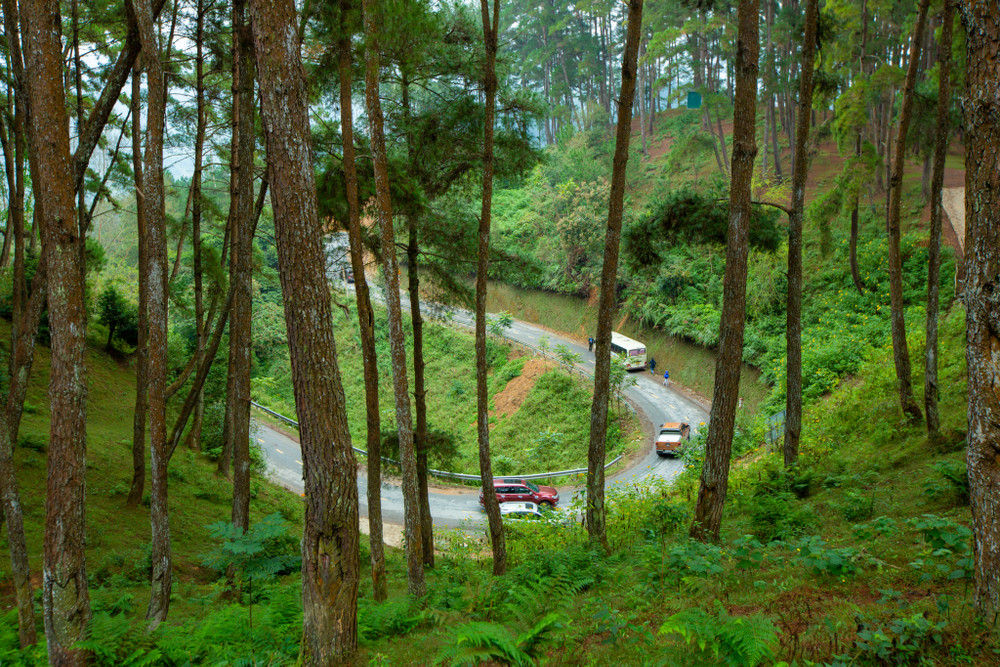
2.3 Conquer magnificent mountain passes
In June, Ha Giang’s skies are typically crystal clear with few clouds, offering exceptionally unobstructed views along mountain passes like Ma Pi Leng, Chin Khoanh, and Tham Ma. These roads hug the mountainsides, continuously winding and revealing successive mountain ranges covered in deep green. The experience of riding through each curve, seeing deep valleys below and layered mountains ahead creates unforgettable memories.
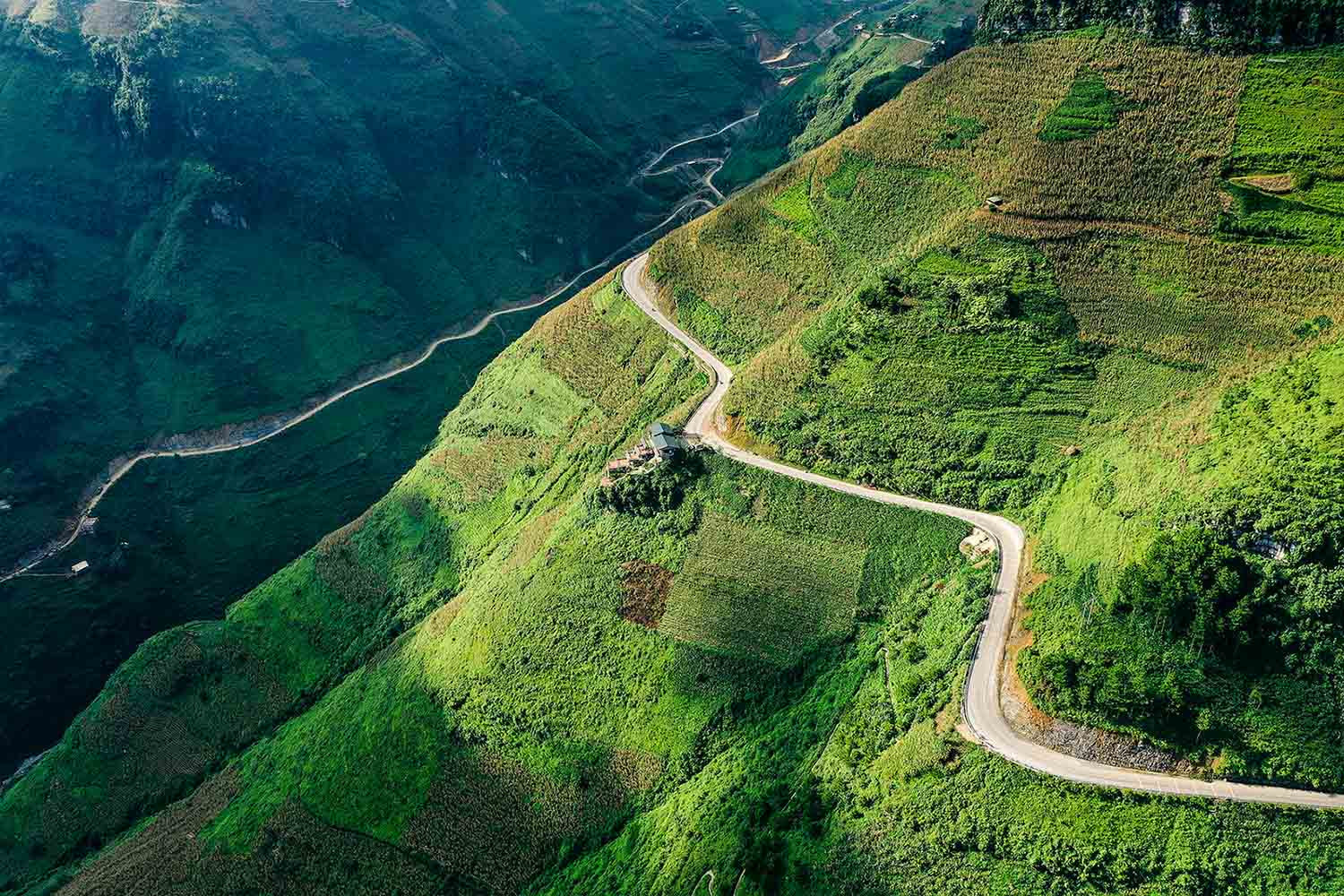
2.4 Explore the Lao and Chai plateau
Located amid Ha Giang’s rocky mountains, about 12km from Yen Minh district center, the Lao and Chai plateau is one of the few wide, flat, and open spaces in the region. Green grass covers the gentle slopes, extending to the base of the mountains, creating a landscape completely different from the familiar mountain passes and terraced fields.
On cloudy days, the entire plateau is immersed in a thin layer of mist, with clouds drifting across the mountainsides, partially obscuring the low earthen houses in the valley below. Along the red dirt paths, goats and horses leisurely graze, leaving small footprints on the damp ground. Wind blowing across the young grass carries the scent of fresh vegetation and earth after rain, making the atmosphere even more refreshing and pleasant.
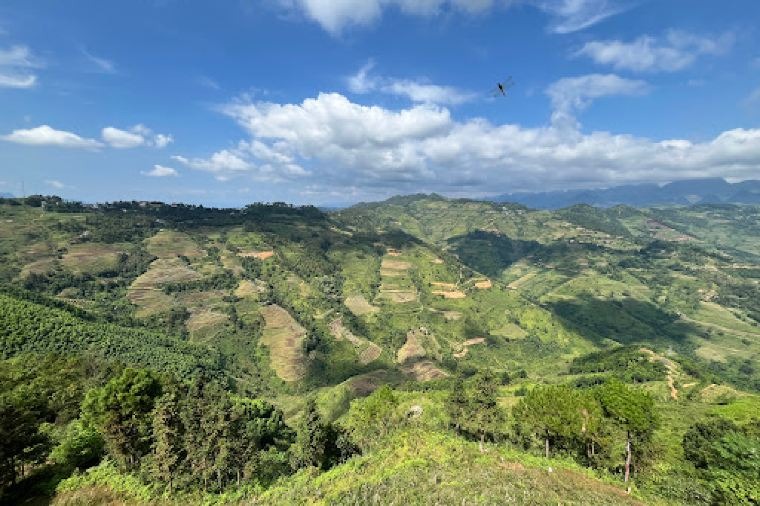
2.5 Visit the sacred Lung Cu Flag Tower
Lung Cu Flag Tower stands atop Dragon Mountain, nearly 1,470 meters above sea level. The current structure, inaugurated in 2010, features a hexagonal design with green stone cladding and six Dong Son bronze drum reliefs at its base. At the top, a 54-square-meter red flag with a yellow star flies proudly, symbolizing Vietnam’s 54 ethnic groups.
The path to the flag tower begins at the foot of Dragon Mountain with 839 stone steps extending along the mountainside. The initial section is relatively easy, but as you climb higher, the slope becomes steeper, making each step more challenging. The final segment is a narrow spiral staircase inside the tower that leads visitors to the viewing platform. Standing here, a magnificent panorama unfolds before your eyes, with layered rocky mountains, winding terraced fields, and deep valleys stretching into the distance.
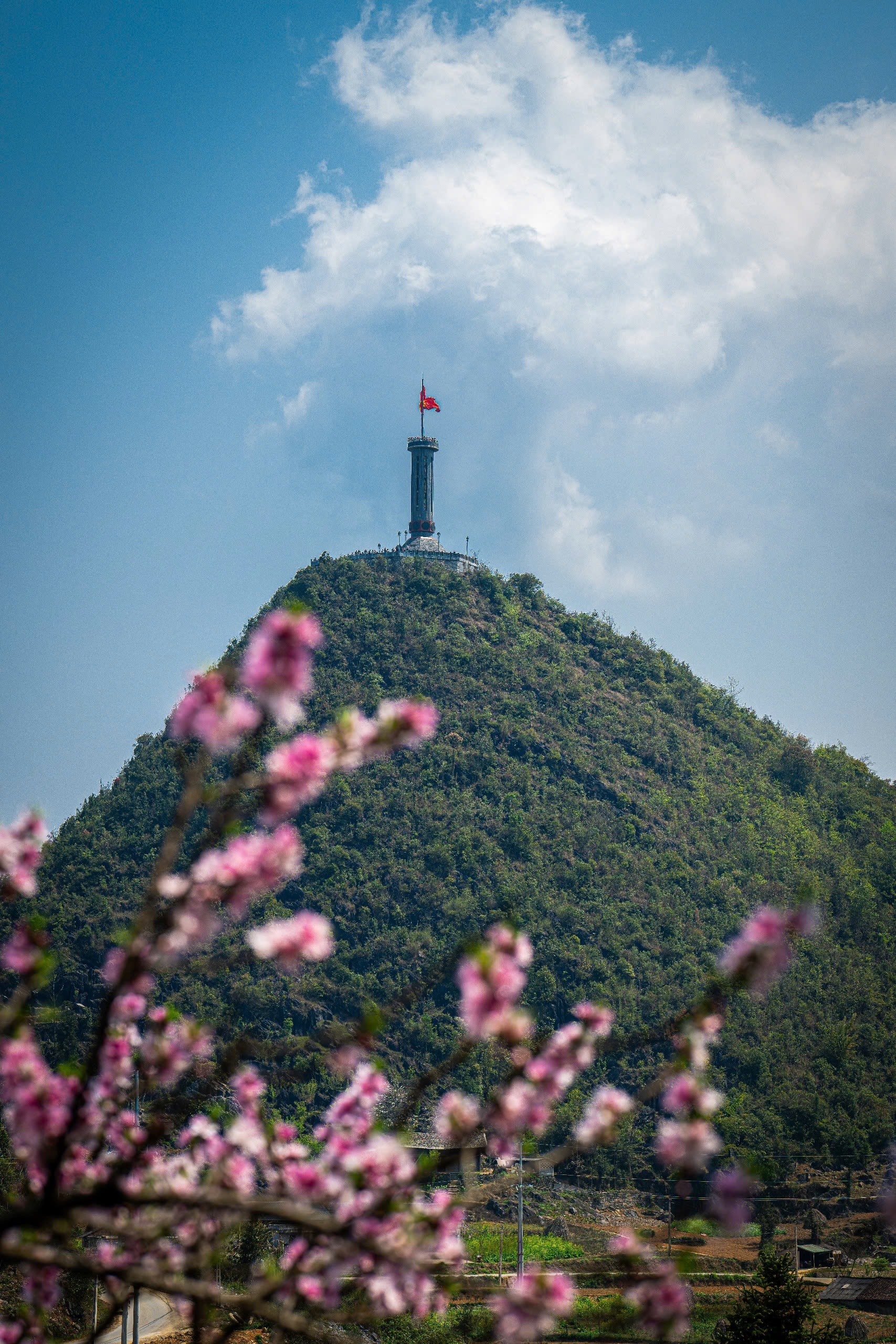
2.6 Admire the quiet beauty of Lung Cam cultural tourism village
Lung Cam cultural tourism village rests peacefully in Sung La valley, Dong Van district. It’s home to 61 households, over 85% of whom are Hmong people. The village is famous for its rammed earth houses with yin-yang tiled roofs and distinctive corn-drying yards characteristic of the rocky plateau region. Through generations, the living space here has maintained its rustic, pristine quality.
Although widely known after the film “The Story of Pao,” Lung Cam still maintains its slow pace of life, untouched by the hustle and bustle of tourism. The sound of looms in courtyards, the glow of embers in small kitchens, or Hmong folk melodies during village festivals… all create the simple charm of this place. Especially in June, seeing locals gathering corn and preparing for the new crop season makes the village feel even more approachable.
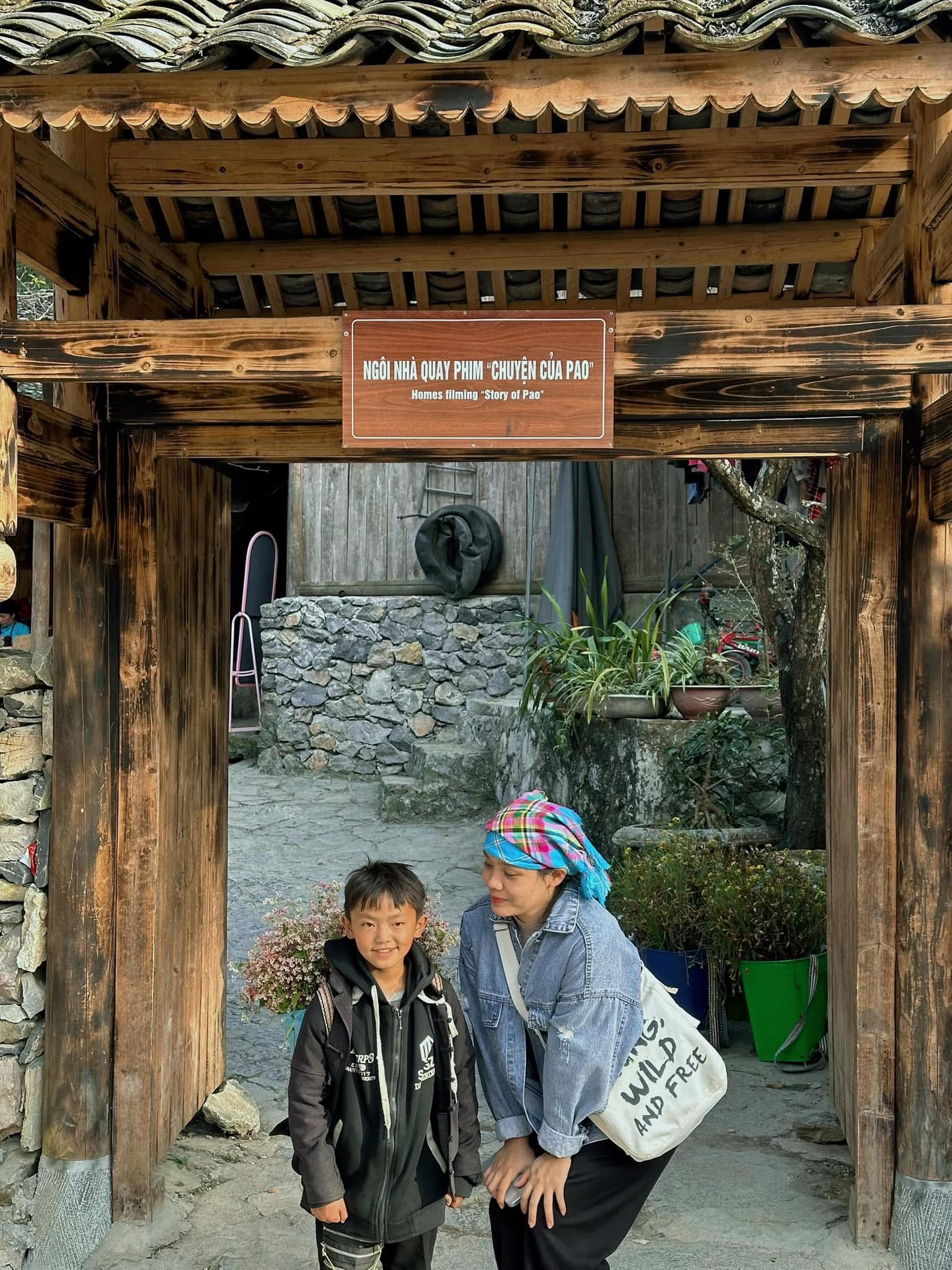
2.7 Tour the historic Vuong Family Mansion
In the heart of Sa Phin valley, the Vuong Family Mansion stands like a living museum, perfectly preserving the unique architectural blend of Chinese, French, and indigenous influences. The structure was built using rare wood with double-tiled roofs, comprising a total of 10 large and small houses connected to each other. Surrounding it are stone walls up to 1 meter thick and 3 meters high, creating a fortress-like appearance amid nature.
Recognized as a National Heritage Site since 1993, this place has become an essential stop when visiting Ha Giang. Visiting the mansion in June, you’ll clearly feel its cool, serene atmosphere. Each step through the stone corridors and moss-covered courtyards seems to connect visitors with ancient stories linked to the life and power of the Vuong family in their heyday.
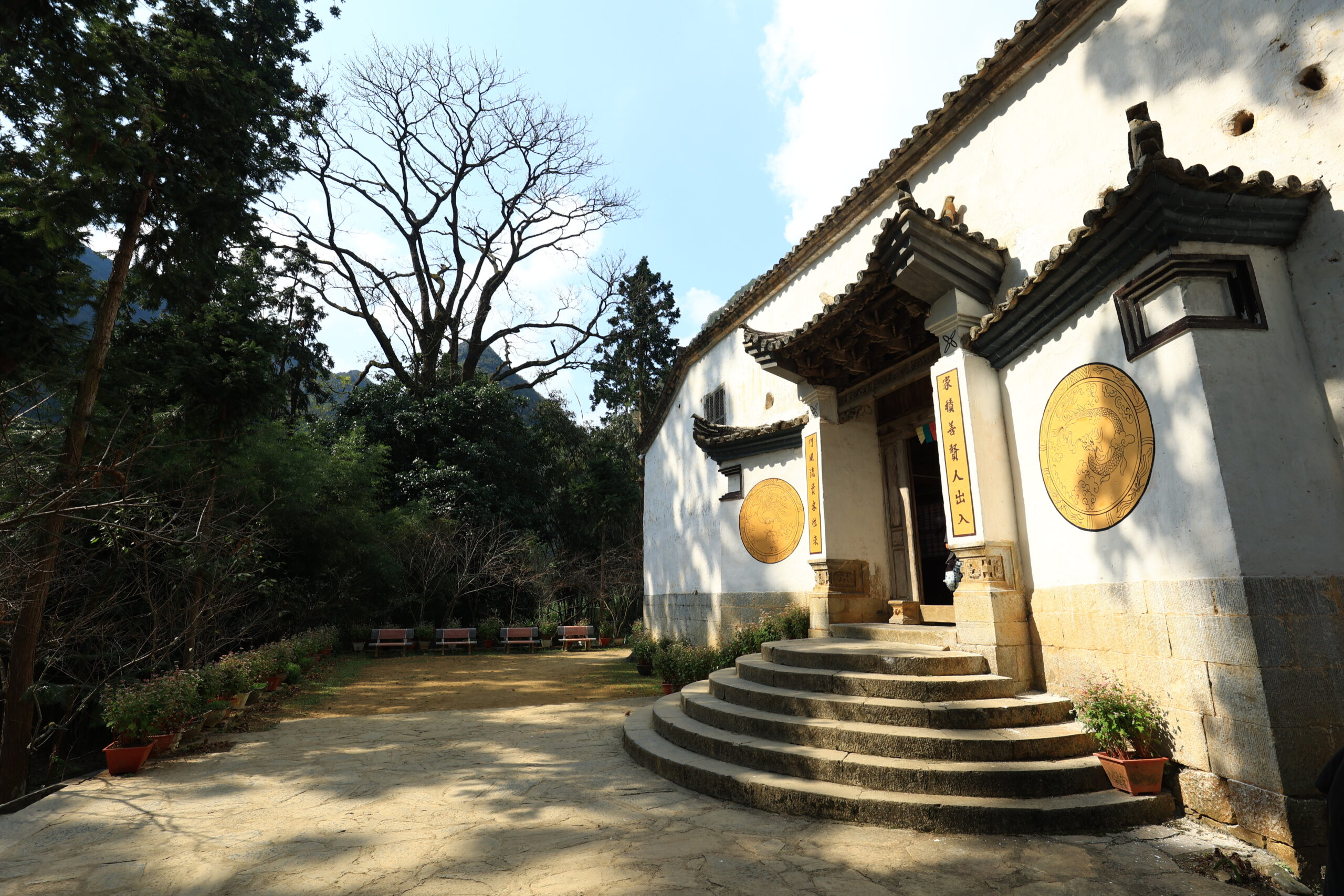
2.8 Experience the bustling highland markets
To understand the rhythm of life in Ha Giang’s rocky region more deeply, nothing is more fascinating than a morning visit to a local market. From dawn when mist still lingers, groups of people make their way to Dong Van Market. Calls to one another, laughter mixed with the sound of footsteps create a lively atmosphere on the ground. Colorful ethnic costumes bring the ancient town to vibrant life.
Not just Dong Van, but Meo Vac and Quan Ba markets are also familiar gathering places. Locals bring fabrics, vegetables, brocades, honey, corn wine… all encapsulating the distinctive highland culture. Amid the bustling crowd, stopping to enjoy a hot bowl of thang co or sipping strong corn wine creates an unforgettable experience for anyone who visits.
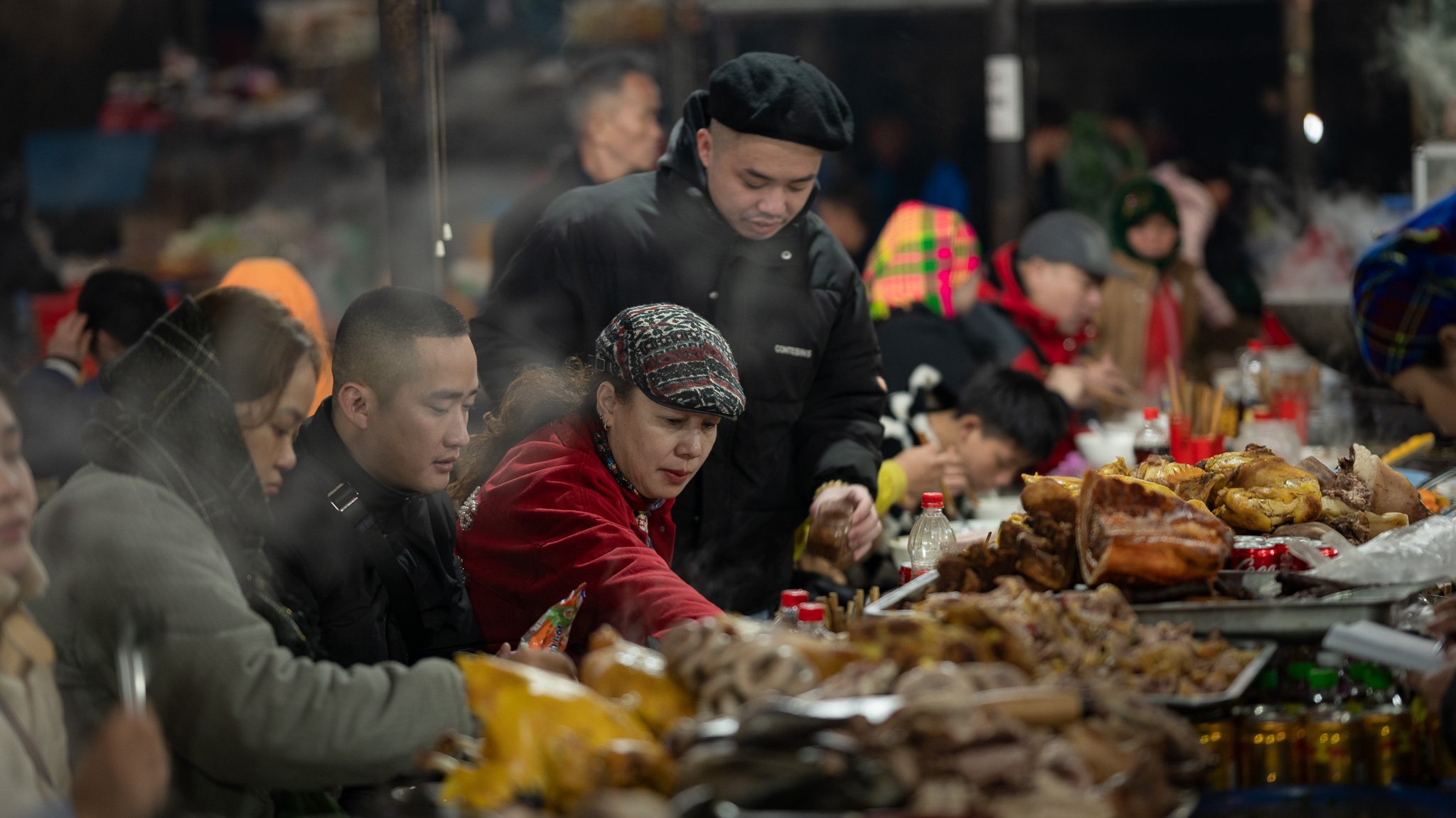
Ha Giang’s Buckwheat Flowers: History, Festival & Hidden Spots
3. How to travel to Ha Giang in June
Hanoi is the common starting point for conquering Ha Giang, with a distance of about 300 km. From here, you can choose to travel by bus, motorcycle, or car. If you’re coming from southern or central Vietnam, you should fly to Hanoi first and then continue to Ha Giang by land transportation.
Hanoi-Ha Giang buses typically take about 7 hours, departing at night and arriving early in the morning. Ticket prices range from 250,000 to 350,000 VND depending on the bus company.
If you prefer flexibility with your itinerary, you can rent a motorcycle or self-drive car. Motorcycle rental prices in Hanoi start from 150,000-250,000 VND per day. As you approach Ha Giang, the roads become more winding with mountain passes, so thoroughly check the brakes, tires, and engine before departing.
4. Must-try dishes when visiting Ha Giang
Ha Giang captivates visitors not only with its winding roads but also with its highland cuisine. When visiting Ha Giang in June, don’t miss these special dishes:
4.1 Smoked buffalo meat
Buffalo meat is marinated with ginger, chili, and mac khen pepper, then hung above the kitchen hearth where smoke slowly dries each fiber. It’s prepared by grilling or steaming, then shredded and dipped in cham cheo sauce or chili sauce. The natural sweetness of the meat blends with the distinctive smoky aroma and spicy kick, making it an unforgettable taste for anyone who tries it.
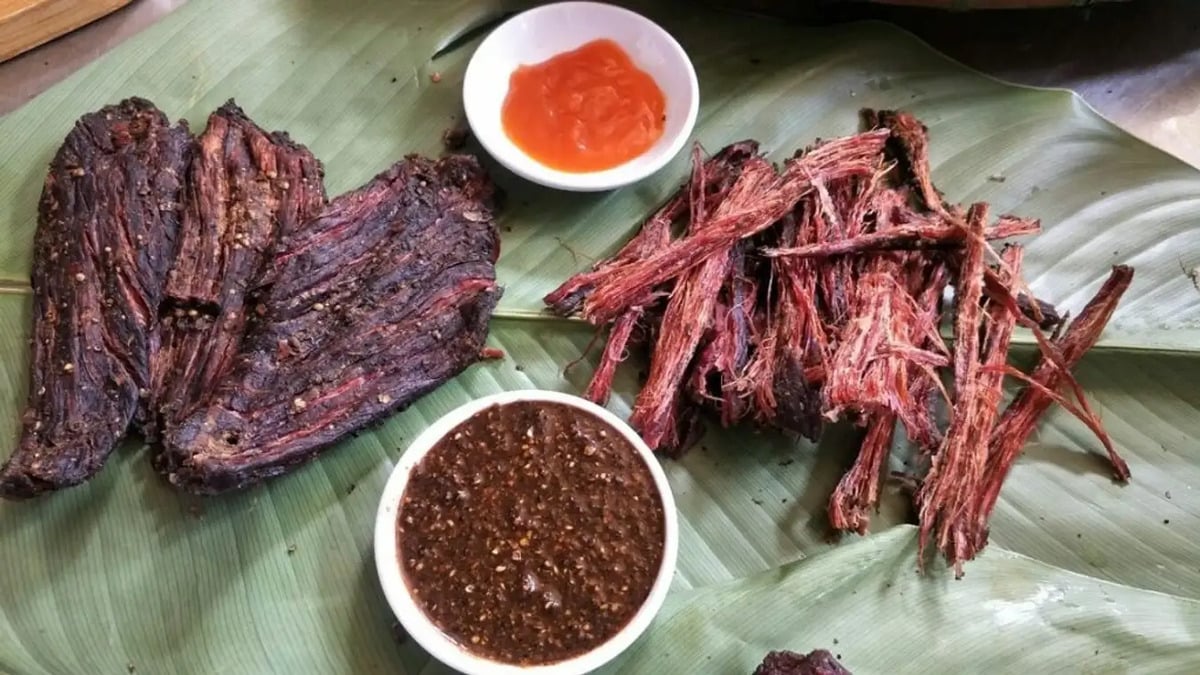
4.2 Hmong thang co
Thang co is a signature Hmong dish, made from horse meat and offal simmered with spices like cardamom, do seed, and mac khen pepper. The dark broth has a distinctive strong aroma that might initially give first-timers pause. But after just one taste, the rich flavor, warming spice, and herbal fragrance quickly explain why this dish is a staple at highland markets throughout Ha Giang.
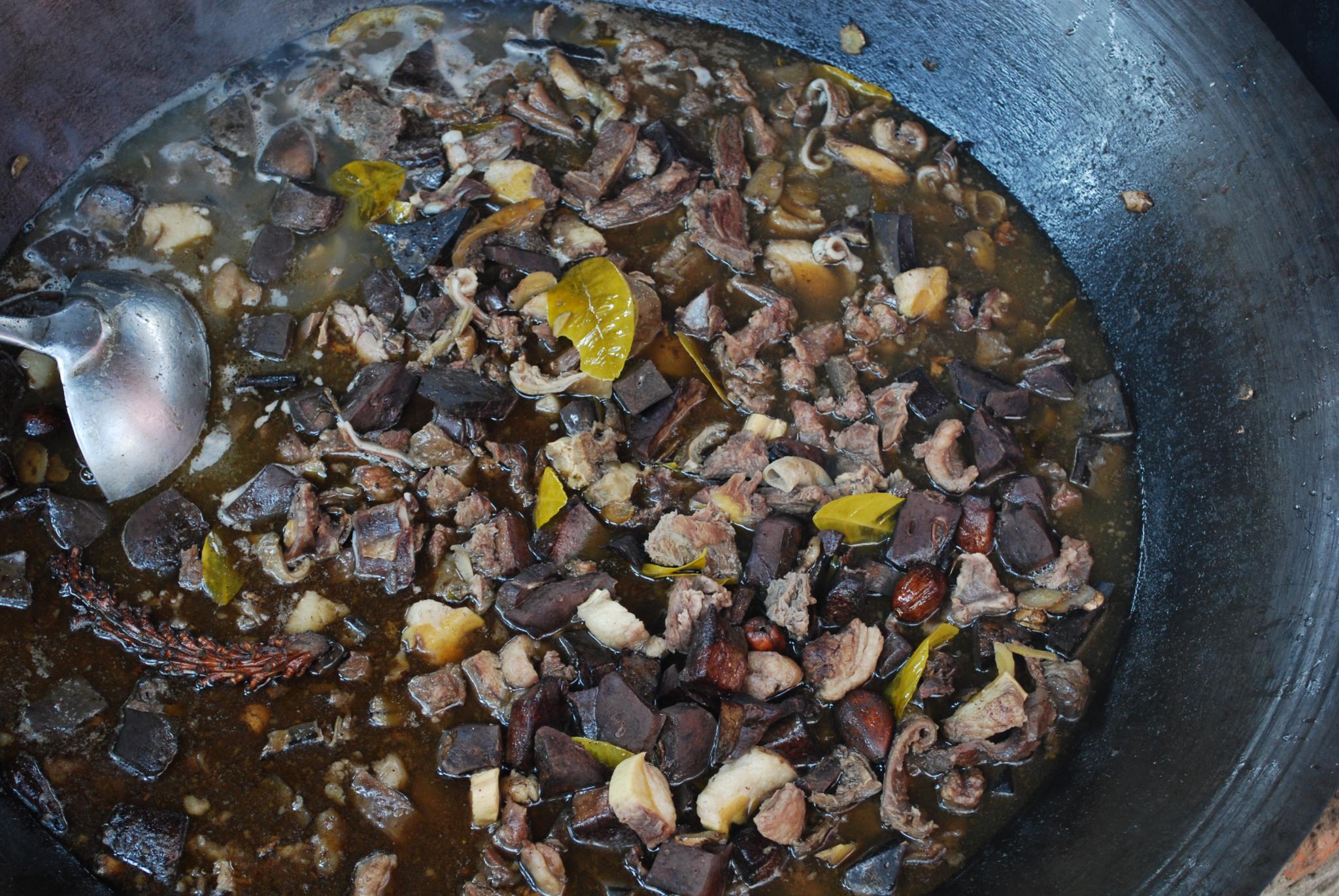
4.3 Buckwheat cake
From Ha Giang’s pink-purple buckwheat fields, locals harvest the seeds to grind into fine flour, mix with water, and shape into small cakes. These cakes are baked over hot coals until the outer layer turns golden, giving off the pleasant aroma of toasted grains. When bitten into, the rich, creamy flavor with a subtle sweetness spreads across the tongue, carrying the rustic, lingering taste of the highland plateau.
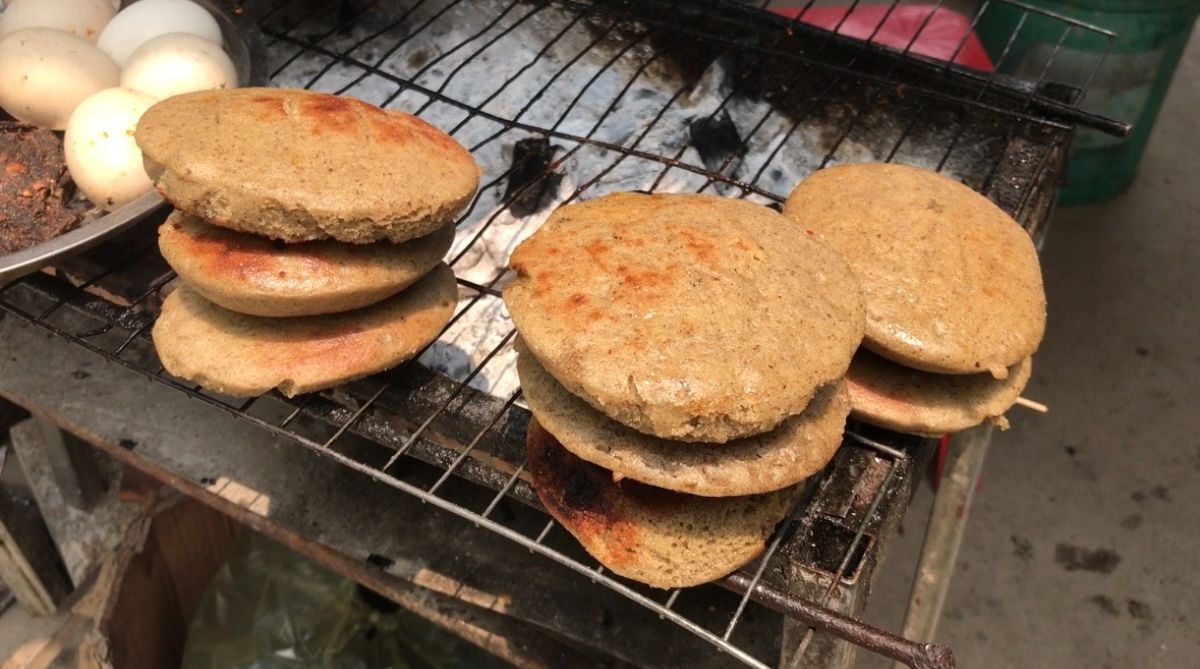
5. Where to stay in Ha Giang?
Your June exploration of Ha Giang will be more complete when you find suitable accommodation. From luxury resorts to simple homestays in villages, each lodging option offers something unique to make your trip more memorable.
P’apiu Resort
A private, secluded retreat featuring rammed earth house designs, highlighted by Vietnam’s longest brocade road.
- Address: Km18, Yen Dinh, Bac Me, Ha Giang
- Reference price: 10,000,000 VND/night
H’Mong Village
A resort with qway tau architecture (traditional musical instrument shape), overlooking the Mien River and majestic mountains.
- Address: Trang Kim Area, Dong Ha Commune, Quan Ba District, Ha Giang Province
- Reference price: Community rooms around 400,000 VND/night, bungalows around 2,400,000 VND/night
Ong Vang Meo Vac
A homestay with simple, cozy spaces at reasonable prices.
- Address: 19th May Street, Meo Vac Town, Ha Giang
- Reference price: 230,000 VND/night
Hoang Than Ancient House (Uncle Than’s Ancient Homestay)
Stay in an ancient house in Dong Van Old Quarter, experiencing historical ambiance.
- Address: Group 4, House No. 10, Old Quarter Street, Dong Van Town, Ha Giang
- Reference price: 100,000 VND/night
6. Phieu Travel explores Ha Giang’s brilliant summer
Ha Giang in June displays vibrant beauty with brilliant blue skies, clearly visible mountain ranges, lush green rice fields during transplanting season, and bustling highland markets. To help you plan easily, Phieu Travel designs flexible tour options suited to various timeframes and individual needs.
6.1 Ha Giang Loop 2 day 1 night tour
Though 2 days and 1 night may seem brief, with Phieu Travel’s carefully designed itinerary, you’ll still experience Ha Giang’s most spectacular highlights. Each stop is strategically arranged to optimize travel time, taking you through the most beautiful mountain passes, visiting local villages, and exploring distinctive cultural features.
Here’s the detailed itinerary for Phieu Travel’s 2-day 1-night Ha Giang tour:
- Day 1: Ha Giang – Bac Sum Pass – Quan Ba Heaven Gate – Fairy Twin Mountains – Yen Minh – Vuong Family Mansion – Dong Van.
- Day 2: Dong Van – Ma Pi Leng Pass – Nho Que River – M-shaped Curve – Duong Thuong – Ha Giang City – Hanoi.
6.2 Ha Giang Loop 3 day 2 night tour
With 3 days and 2 nights, you’ll have more time to deeply experience the rocky highland lifestyle and explore more destinations on your June Ha Giang journey. Phieu Travel’s itinerary balances sightseeing, cultural experiences, and rest periods, helping you avoid fatigue despite traveling through many mountain passes.
Here are the detailed stages of Phieu Travel’s 3-day 2-night Ha Giang tour:
- Day 1: Ha Giang – Bac Sum Pass – Quan Ba Heaven Gate – Fairy Twin Mountains – Yen Minh – Vuong Family Mansion – Dong Van.
- Day 2: Dong Van – Ma Pi Leng Pass – Nho Que River – M-shaped Curve – Duong Thuong – Du Gia.
- Day 3: Du Gia – Thai An – Ha Giang City – Hanoi.
6.3 Ha Giang Loop 4 day 3 night tour
The 4 day 3 night journey expands beyond the shorter tours. In addition to familiar spots like Dong Van and Ma Pi Leng, you’ll discover lesser-known villages such as Du Gia, Nam Dam, and Thai An. The itinerary moves at a slower pace with more time for experiences, helping you connect more deeply with the culture, lifestyle, and pristine beauty of Ha Giang that shorter trips might miss.
Phieu Travel’s 4 day 3 night Ha Giang tour itinerary:
- Day 1: Ha Giang – Bac Sum Pass – Quan Ba Heaven Gate – Fairy Twin Mountains – Yen Minh – Vuong Family Mansion – Dong Van.
- Day 2: Dong Van – Ma Pi Leng Pass – Nho Que River – M-shaped Curve – Duong Thuong – Du Gia.
- Day 3: Du Gia – Duong Thuong – Nam Dam Village.
- Day 4: Nam Dam – Thai An – Ha Giang City – Hanoi.

Whether you choose the 2 day 1 night, 3 day 2 night, or 4 day 3 night tour, all are designed by Phieu Travel as all-inclusive packages. All costs from transportation, accommodation, meals to entrance fees are prepared in advance. You just need to pack your backpack and enjoy the journey without worrying about any additional expenses.
The Ultimate Ha Giang Loop Guide (2025): Itinerary, Map & Tips
7. Tips for traveling to Ha Giang
To make your June exploration of Ha Giang truly complete, here are important tips to keep in mind:
- Prepare good health:The terrain features many steep passes and long continuous roads, so limit carrying heavy items and pace yourself throughout the journey.
- Consider your transportation options:Most routes in Ha Giang require motorcycle travel. If you’re unfamiliar with the roads or have limited riding skills, consider booking Phieu Travel’s all-inclusive tour with local drivers.
- Bring basic medications:Especially insect repellent, stomach pain relief, bandages, and some common cold and fever medicines.
- Prepare for electronic devices:Cameras and phones need waterproof cases and backup batteries, especially during rainy days or when traveling through humid areas.
Ha Giang in June is the ideal time to experience the crystal-clear beauty of Vietnam’s northern mountains. From terraced fields during water-filling season, sun-drenched mountain passes to bustling highland markets, each moment leaves an unforgettable impression. With diverse itineraries, all-inclusive services, and dedicated companionship, Phieutravel.com will help you enjoy a brilliant and memorable summer journey in Ha Giang.
Read more:
- Cloud hunting in Ha Giang: 7 Breathtaking spots that will capture your heart
- The White Cliffs of Ha Giang: A Path for Adventurous Hearts
- Ha Giang Sour Pho: An Irresistible 300-Year-Old Northeast Delicacy
- Lung Ho, Ha Giang complete guide to Vietnam’s Hidden Gem

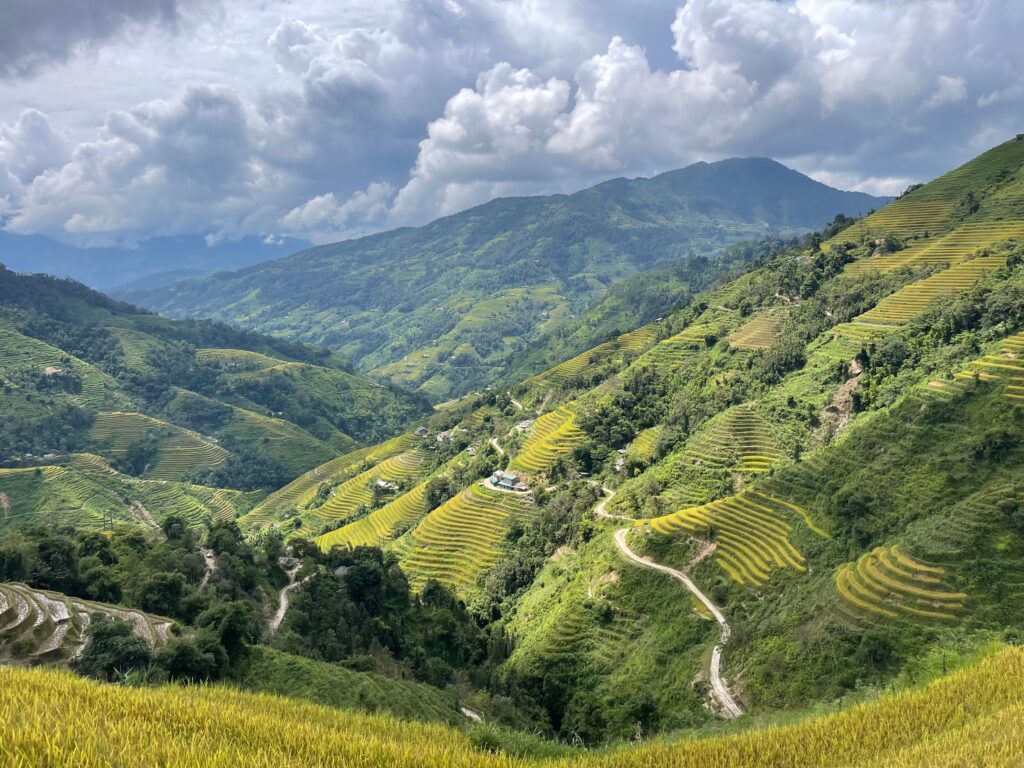
You Might Also Like
Ha Giang Weather in September: Complete Guide for Travelers
Exploring the magnificent Ha Giang Loop in September offers travelers a perfect balance of favorable[...]
Quan Ba Twin Mountains: Ha Giang’s Iconic Fairy Hills and Complete Travel Guide
The mystical Quan Ba Twin Mountains rise from the emerald valleys of Ha Giang like[...]
Vuong family mansion: the architectural marvel and cultural legacy of Ha Giang
Deep in Vietnam’s northern highlands, where mist-shrouded mountains meet terraced rice fields, stands a testament[...]
Ha Giang Loop Safety Tips: How to Ride Securely in Vietnam’s Northern Mountains
The Ha Giang Loop, with its winding mountain roads and breathtaking landscapes, offers one of[...]
The Ultimate Guide to the M-Shaped Curve on Ha Giang Loop
Vietnam’s remote northern province of Ha Giang hides a natural wonder that has captivated adventurous[...]
Most Beautiful Places to Visit in Vietnam: Essential Destinations and Insider Tips
Vietnam captivates travelers with its stunning landscapes, rich cultural heritage, and warm hospitality. From mist-shrouded[...]
Beyond the Beaten Path: Discovering Ha Giang Province in Northeast Vietnam
Ha Giang Province in Northeast Vietnam stands as one of the country’s last frontiers for[...]
Rainy season in Ha Giang: what to expect, when to go, and travel tips
Vietnam’s northern frontier reveals a different face during the rainy season, transforming Ha Giang’s limestone[...]